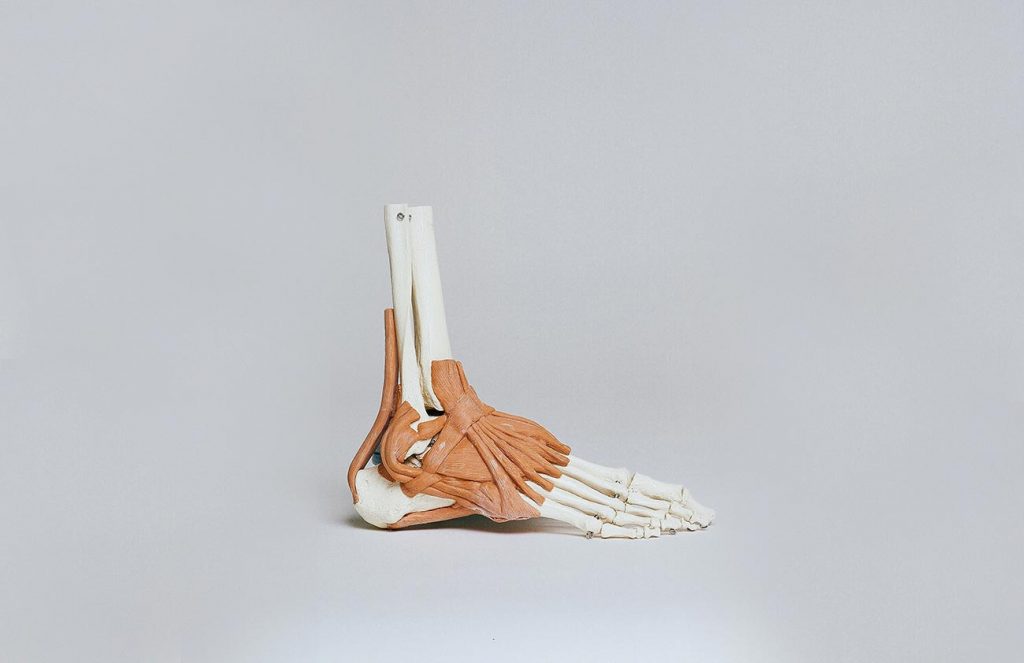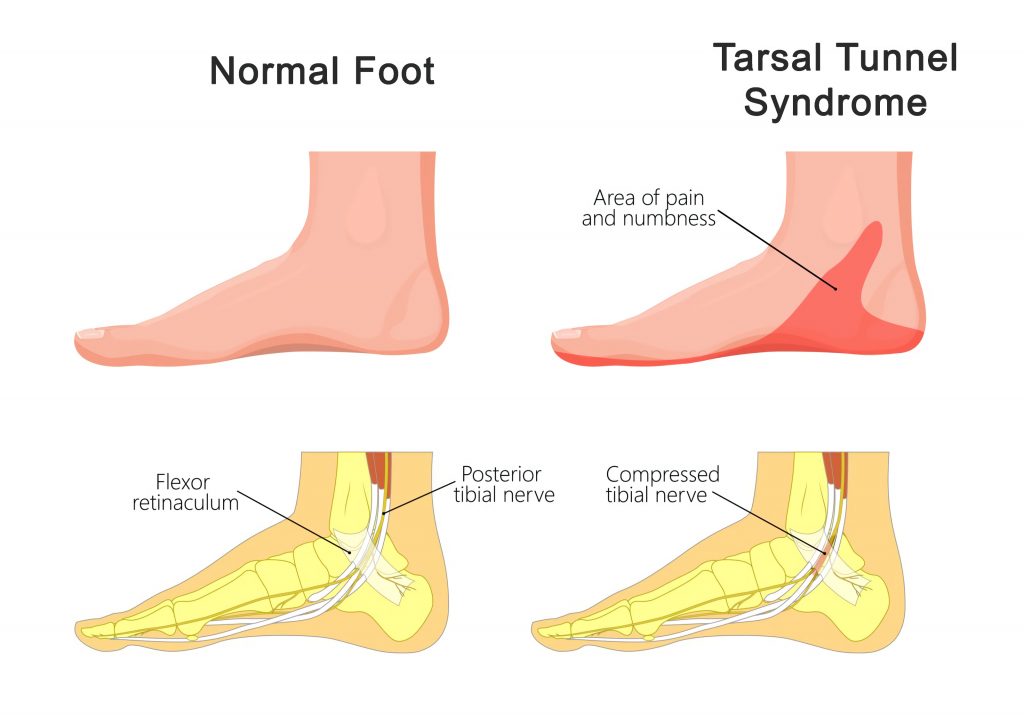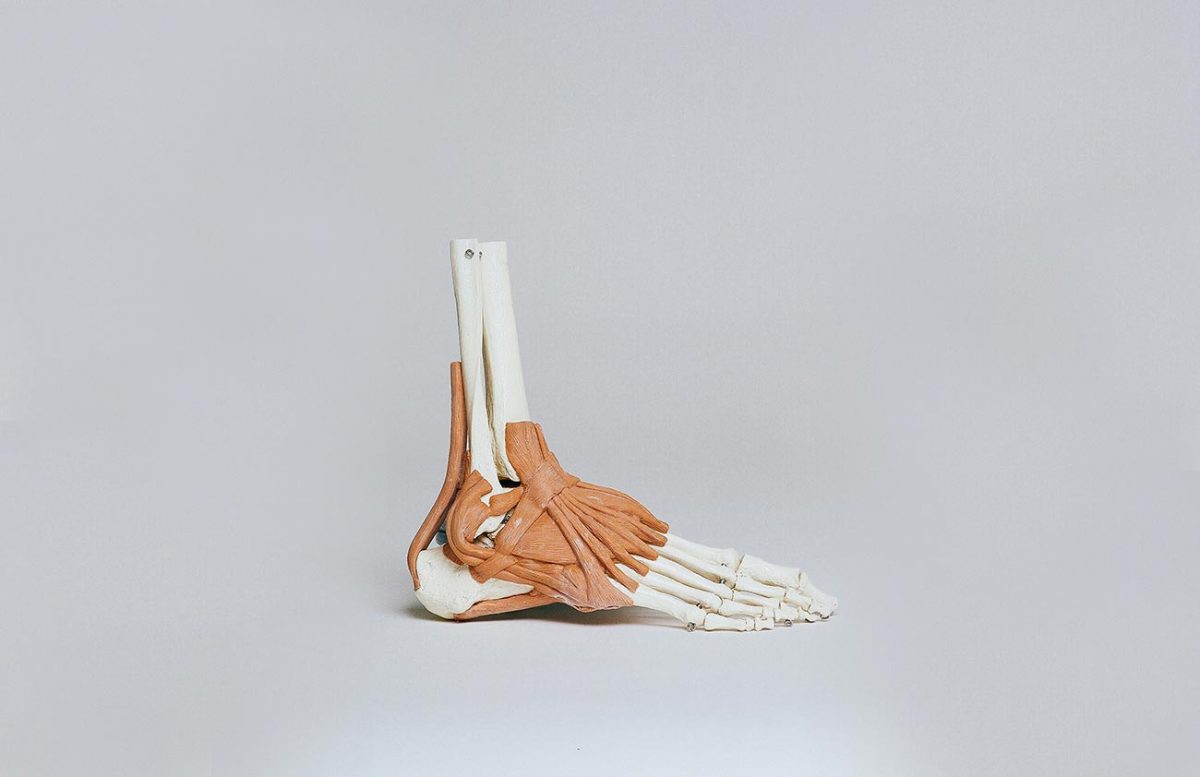Tarsal Tunnel Syndrome
![]()
Call (703) 520-1031 or use the form below to send us your contacts.
What is Tarsal Tunnel Syndrome?

The ankle is a complex set of bones, joints, tendons, ligaments, arteries, veins, and nerves. One of its components is the tarsal tunnel, a narrow tunnel-like space found on the inside of the ankle, lying next to the ankle bones. The ligament-wrapped tarsal tunnel protects tissues that enable flexibility and movement of the foot, including tendons, blood vessels, and nerves.
One of the nerves found in the tarsal tunnel is the posterior tibial nerve. This nerve runs down the back of the calf, through the tarsal tunnel near the heel, and into the foot’s sole. Tarsal tunnel syndrome occurs when the nerve is compressed in the tunnel for some reason, producing a set of symptoms.
Causes of Tarsal Tunnel Syndrome
Anything that can compress the posterior tibial nerve can cause the syndrome.
- Ankle sprain or another injury that causes inflammation and swelling
- Repetitive strain injury
- Flat feet leading to fallen arches
- Diseases that cause tissue swelling, like diabetes or arthritis
- Ganglion cyst
- Bone spur
- Swollen tendon
- Varicose vein
Tarsal Tunnel Syndrome Symptoms

The tarsal tunnel syndrome symptoms are usually experienced on the bottom of the foot or on the inside of the ankle. The symptoms may also occur in one location, or pain may radiate along the nerve all the way to the toes, heel, arch, and sometimes the calf.
The typical symptoms of tarsal tunnel syndrome (TTS) include the following.
- Pain
- Burning sensation
- Tingling
- Numbness
The pain experienced with this syndrome can take many forms. It could be chronic pain in one location or shooting pain that extends from the ankle and into the foot and toes. There could be a stabbing pain in the foot side. It may be pain between the heel and ankle that gets worse when walking but seems to get better when resting.
The pain, tingling, and burning sensations may initially occur when the person walks, stands, or wears a particular shoe. Eventually, though, there is a good chance the tarsal tunnel syndrome symptoms will worsen without intervention, and the pain is not relieved while resting.
Diagnosis
One of the challenges of getting an accurate diagnosis is the fact tarsal tunnel syndrome can be confused with plantar fasciitis. They are two different medical conditions that may have a similar clinical presentation. Similar to tarsal tunnel syndrome plantar fasciitis may cause heel, arch, or calf pain, but the causes of the pain are different. Plantar fasciitis pain is caused by inflammation or tearing of the plantar fascia ligament that runs along the bottom of the foot.
To diagnosis tarsal tunnel syndrome, the doctor will:
- Place the foot in various positions and tap on the nerve just below the ankle bone to see if the symptoms are reproducible
- Manually press on the nerve to check for a mass
- Order nerve conduction studies when necessary to obtain an accurate diagnosis
- Order imaging tests like x-rays, MRI or CT scan
Nerve conduction studies include electromyography and nerve conduction velocity. These diagnostic procedures are usually ordered if non-surgical treatment does not improve the condition.
Treatment
Naturally, people want to know how to cure tarsal tunnel syndrome. Non-surgical tarsal tunnel syndrome treatment is always the first approach. One or more of the following treatments are usually recommended.
- Resting the foot to allow healing when an injury or overuse caused the inflammation
- Taking nonsteroidal anti-inflammatory drugs (NSAIDs) to reduce inflammation and ease pain
- Applying an ice pack to the painful area several times a day
- Using orthoses (custom constructed shoe inserts) in the shoe for arch support and to limit excessive movement that compresses the nerve
- Changing the type of shoes worn to ones that are more supportive
- Seeing a physical therapist who can help patients with targeted exercises and other modalities that can reduce symptoms
- Getting an injection of corticosteroid to reduce inflammation or an injection of a local anesthetic to reduce pain
- Wearing a compression stocking on the leg to promote the flow of blood out of the leg to reduce swelling in the ankle and foot
Sometimes, the doctor may recommend wearing a cast to immobilize the foot so the nerve and other tissues can heal. Another option for patients with severe symptoms is to be fitted with a brace that reduces pressure on the foot. The last resort treatment is a surgical procedure called tarsal tunnel release.
FAQ
Who Diagnoses Tarsal Tunnel Syndrome?
The first doctor people visit is usually the general practitioner. If the general practitioner believes a specialist should check out the ankle and foot to pinpoint the condition, he or she will refer you to a podiatrist or an orthopedic surgeon.
How Serious is Tarsal Tunnel Syndrome?
Tarsal tunnel syndrome can be very serious when left untreated. The condition will get progressively worse and can lead to permanent nerve damage. In addition, the pain and other symptoms of the syndrome can interfere with life activities. Another point to keep in mind is that getting a proper diagnosis is important to ensure it really is tarsal tunnel syndrome and not some other medical condition. This is the only way to develop the correct treatment plan.
Who is Susceptible to Tarsal Tunnel Syndrome?
The people most at risk of developing tarsal tunnel syndrome are those who have a structural abnormality in the foot, like flat feet or weak ankles prone to injuries. Flat feet can be present at birth or acquired over time. Another high-risk group is people who have jobs that require a lot of standing or walking and people who do a lot of jogging or other foot-pounding activities. These activities place excessive pressure on the ankle and foot, as does being overweight or obese. Other risk factors include diseases like arthritis, diabetes, and heart disease because they cause swelling in the lower extremities.
How Long Does Tarsal Tunnel Syndrome Last?
The length of time the tarsal tunnel syndrome lasts depends on what caused the syndrome to develop. A minor injury, like a sprain that caused swelling and nerve compression, can improve significantly within two days (48 hours) by following the RICE strategy, the acronym for “Rest, Ice, Compression, Elevation.” If the condition is due to something like disease or flat feet, it can take much longer. The important point is to not leave the tarsal tunnel syndrome untreated because it can worsen to the point of causing permanent damage.
